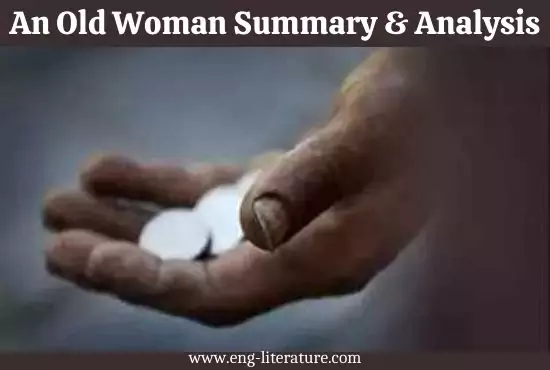An Old Woman by Arun Kolatkar
Table of Contents
Introduction
In the poem ‘An Old Woman’, Arun Kolatkar wonderfully paints the graphic picture of an old begging woman. The decay of this old woman here clearly symbolizes the decay in our own lives, in our society.
An Old Woman Summary
At Jejuri, an old woman catches hold of a pilgrim in order to extract some money from him. She is a very poor woman who earns her living by begging money from the pilgrims who go to Jejuri. Her demand is very modest because she asks a pilgrim for only a fifty-paise coin; and, when the pilgrim shows his unwillingness to give her the money, she says that, in return for the money, she would take him with her and show him the Horseshoe Shrine. Some pilgrims would readily give money to this old beggar-woman but there are others like the protagonist (Manohar) who, having gone to Jejuri not as a pilgrim but as a casual visitor wanting to observe what kind of a place Jejuri is and what goes on there, would not like to part with any money.
When the pilgrim replies that he has already seen that shrine, she still clings to him and, in fact, tightens her grip on his sleeve. The pilgrim looks at her with an expression of finality, indicating his refusal to give her any money. But the woman still does not leave him and says that a poor old woman has no alternative but to maintain herself on the charity of people.
Also Read:
The pilgrim then looks up at the sky, and a moment afterwards he once again turns his gaze upon her, indicating his unwillingness to give her anything. The pilgrim undoubtedly feels overwhelmed by his feelings but is still unwilling to give her any money. It seems to him that her poverty and his refusal to give her any money have combined to cause sudden cracks in the hills and in the temples. He even gets an impression that the sky has fallen down to the earth with a loud sound, shattering everything except the withered old woman who alone stands before him.
At this, the pilgrim thinks that he has been reduced to a nonentity (or a person of no significance at all). The pilgrim feels as unimportant as the small coins which the old woman has collected from other pilgrims and which she is holding in her hand.
An Old Woman Analysis
This poem may be called a vignette. (A vignette is a sketch of a person or of a scene or of a place). Here the poet has drawn the portrait of an old beggar woman, begging money from the pilgrims who go to Jejuri.
The portrait of the old woman in this poem is very vivid, very realistic, very convincing, and very interesting. The poet has used the right words to draw the portrait; and he has depicted the woman’s behaviour and his own reactions to her most effectively. In fact, it is one of the finest poems in the whole sequence. It is one of the few poems in which the protagonist feels genuinely moved. In other words, the sight of the old woman and her behaviour arouses his human sympathy even though, throughout the poem, he expresses his reluctance to give her any money. The poem is a model of simplicity and clarity.

Hello, Viewers! Besides being the Founder and Owner of this website, I am a Government Officer. As a hardcore literary lover, I am pursuing my dream by writing notes and articles related to Literature. Drop me a line anytime, whether it’s about any queries or demands or just to share your well-being. I’d love to hear from you. Thanks for stopping by!

Thank you. Wonderful job.
Welcome
I don’t know if it is appropriate to say this but I think that the old woman is not a beggar who lives on the charity of others. She wants to tive her life indipendently by offering to take the piligrims to the shrine even for only 50 paise. If you don’t understand this, I suggest this writer to re-read the poem and give correct summary. Sorry if I offended anyone.
Yes!!!
you are right…
Thank you